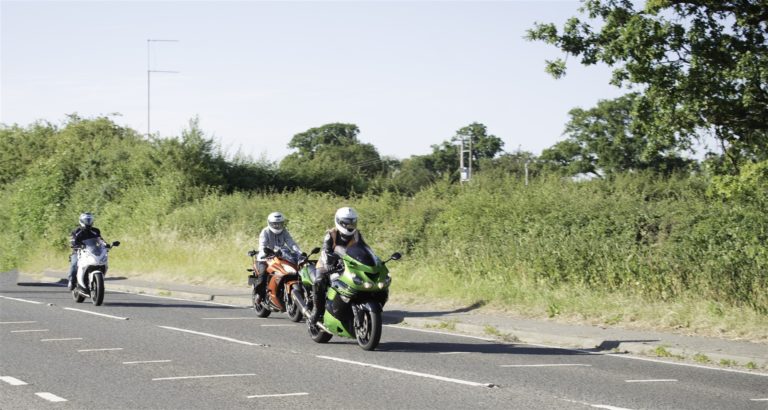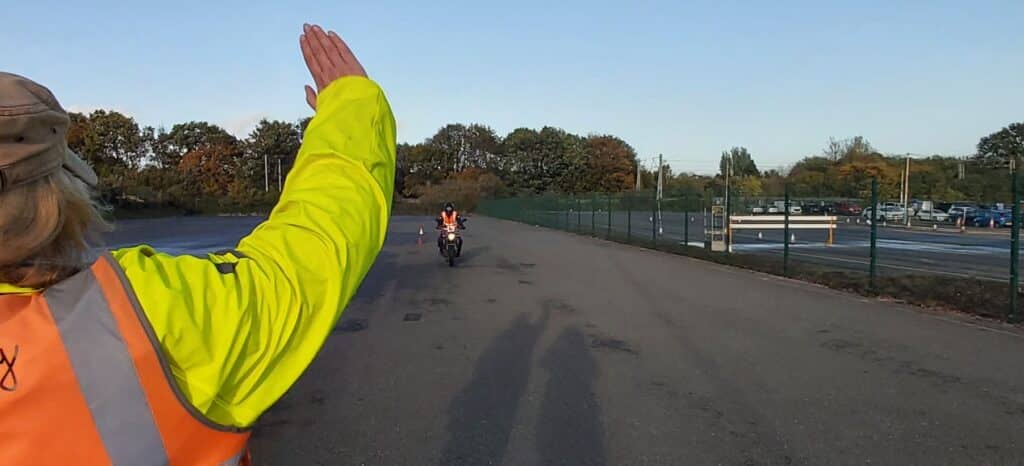

Poor planning and forward observations are the main contributors to riders having to carry out an emergency stop. Whilst learning, novice riders are at greater risk but most riders never practise Emergency Stops after passing their motorcycle test.
An emergency stop should be the last resort, as good forward planning will in most cases prevent the need for such an aggressive braking manoeuvre. In the early stages of riding, novice riders concentrate on what they and the bike are doing. This leaves limited planning time for what lies ahead.
As ability and skills grow, forward vision gets better and riders spend less time thinking about the motorcycle. It’s far better to identify hazards early enough so that a controlled reduction of speed and/or a change in road position can be executed. This will prevent the need for an emergency stop because of a lack of vision and awareness.
Hazards and problems do not just appear. There is a build up period, that in most cases, if seen early enough can be dealt with without the need to carry out an emergency stop to avoid a collision.
In the event that emergency braking is required, riders should keep the bike upright and continue travelling in a straight line.
Most modern motorcycles have ABS (Anti-lock Braking System), which means the brakes will take care of an aggressive application of the brakes. The brake lever will judder and the rider will feel that through the fingers. The brake is released and applied automatically, so the rider does not have to release and reapply.
In the event that the bike does not have ABS and a wheel locks up because of excessive braking. You should release the brakes immediately to regain traction and then re-apply them with less pressure.
Locking the wheels and having to release the brakes will cause the motorcycle’s braking distance to extend, correct braking techniques through practice will eliminate the possibility of the wheels locking up under heavy braking.
Keeping the steering straight during an Emergency Stop will maintain balance. If steering input is used the bike will naturally want to veer off course.
This may create extra problems with skidding or losing traction as the wheel loses grip. Maintaining a straight course is imperative to carry out an emergency stop safely.
There is no need for gear changes during the emergency braking manoeuvre, as braking is the priority to avoid a collision.
Pulling the clutch in too early or if gear changes are made will cause the rear wheel to lose drive. It will be free wheeling/coasting and has a greater chance of locking up and causing a skid.
Pulling the clutch in will stop engine braking which could also extend the braking distance. Try to pull the clutch in as the bike comes to a stop, this will prevent the bike from stalling.

Once the emergency stop has been carried out, you must be aware of your surroundings.
Good awareness by using mirrors and shoulder checks is required. You must be prepared to react quickly, locate the first gear and move away from the stationary position if needed.
You may need to move because the vehicles behind may also need to react quickly and also carry out an emergency stop behind you. Staying in a vulnerable position may result in you being hit from behind if the vehicles do not react quickly enough.
All riders, whether they are inexperienced or not, must ride with a good defensive attitude. You must be able to stop within the distance that you can see to be clear on your side of the road.
You must always be able to stop safely and within your own ability without losing control of your motorcycle. Do not ride faster than 80% of your ability.
Riders tend to travel too fast for the conditions and their own personal ability. Do not fall into this trap. Combine speed with a lack of experience, ability, judgement and skill and you have a recipe for disaster.
To add to this, if you have limited knowledge of the bikes performance and characteristics you will also be at a higher risk. Riding at a slower speed gives more thinking time, which also gives you greater reaction time.
Always think safely, and plan ahead with a good forward vision which reduces risk and the likelihood of needing to carry out an emergency stop.
If an emergency stop has had to be implemented, keep an eye on what is happening behind you. Because if you have done an emergency stop, the vehicles behind may have to do one as well.
Ride safely and Keep it on the Black Stuff.
Written by Simon Hayes
Become a member today to gain access to our courses and exclusive member content* including:
* Content may differ between each membership

Sorry. You must be logged in to view this form.
"*" indicates required fields